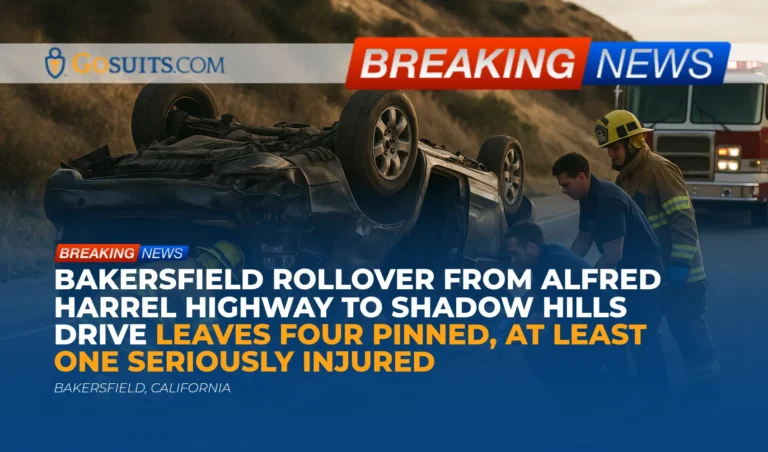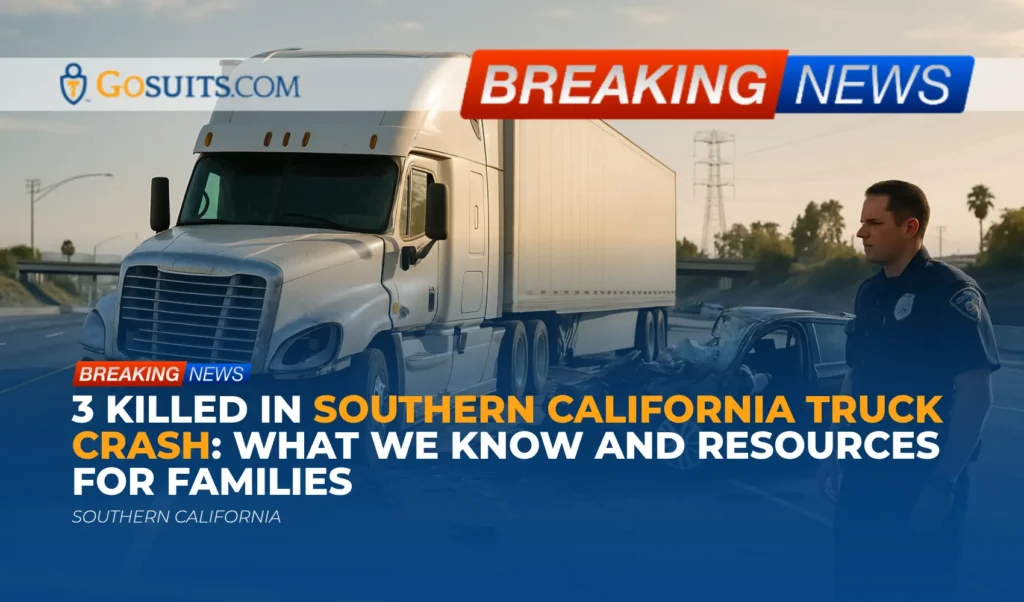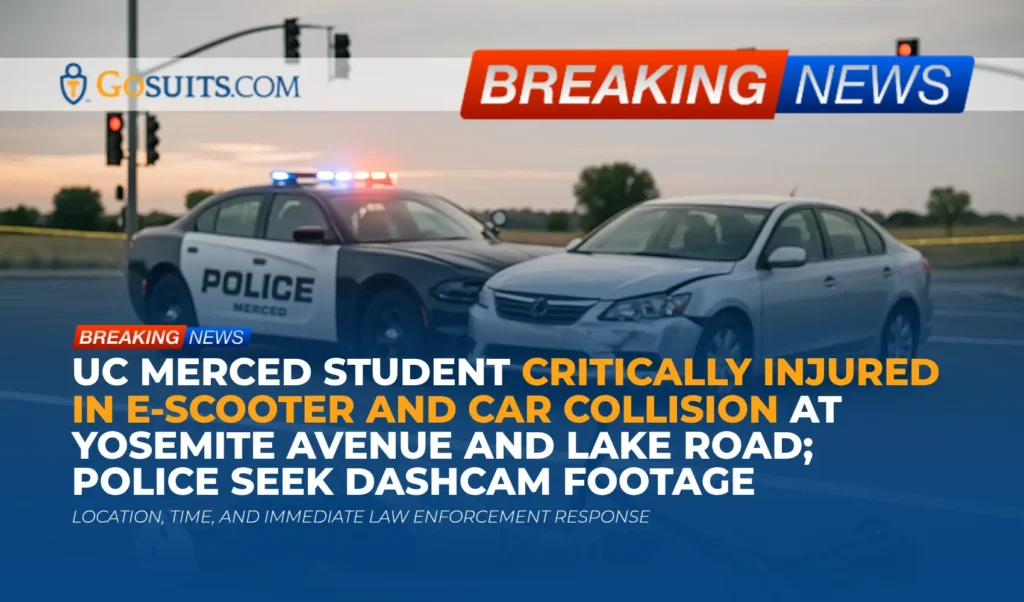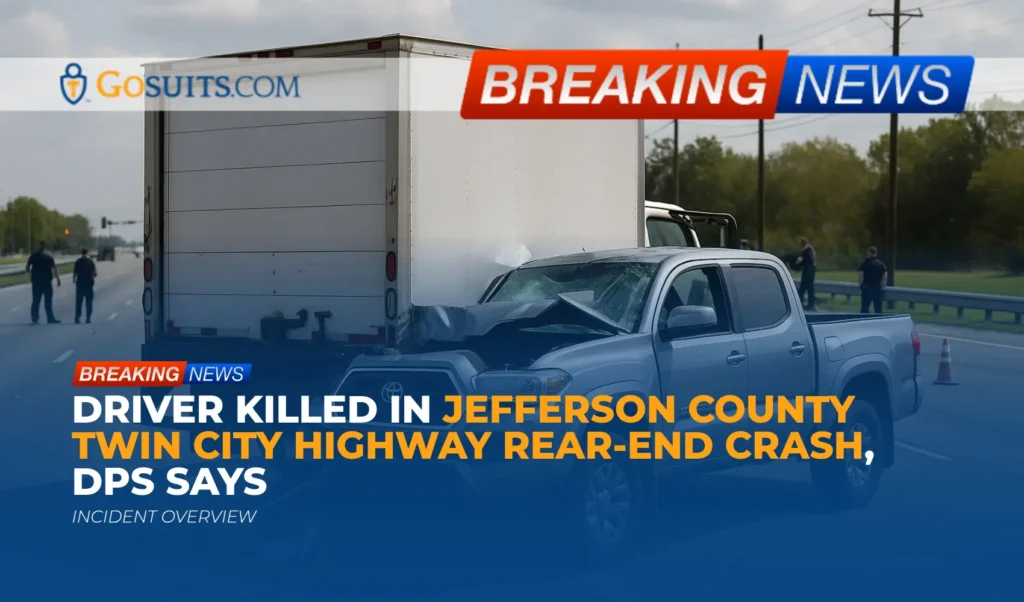- Incident overview and what is known
- Where it happened and why location details matter
- Rollover crashes: how they happen and common injury patterns
- Immediate steps after a serious rollover
- How to obtain official records
- Preserving evidence and documenting losses
- Insurance coverage and claim pathways in California
- Potential liability considerations
- Timelines and legal deadlines that may apply in California
- Community safety notes for the Shadow Hills Drive and Alfred Harrel Highway area
- What families and friends can do to support injured victims
- Why prompt action matters
- Commentary from Gosuits Bakersfield, California Personal Injury Attorney
Incident overview and what is known
A Sunday night rollover crash was reported at approximately 8 p.m. on Shadow Hills Drive in Bakersfield. According to publicly available information from the California Highway Patrol, a vehicle reportedly rolled over from Alfred Harrel Highway onto Shadow Hills Drive. Four people were pinned inside the vehicle; all were reported to be breathing, but two were unconscious at the time responders arrived. Medical personnel and fire crews were dispatched and worked at the scene to access the occupants and provide emergency care. A later update indicated at least one person suffered major injuries. As of the latest available update, it is not yet known what caused the crash. No names have been publicly released at this time.
Rollover collisions are traumatic events with a high likelihood of serious injury. The details shared so far suggest significant forces were involved, given that all four occupants were pinned and two were unconscious. It is standard for first responders to extricate occupants, stabilize them, and coordinate transport to area hospitals with appropriate trauma capabilities. When a cause is unknown, investigators typically look at roadway conditions, vehicle condition, driver inputs, speed, seat belt use, and possible external factors such as debris or another vehicle’s involvement.
Because the investigation appears to be ongoing, it is important for community members to allow investigators the time they need to reconstruct what happened and determine contributing factors, if any.
Where it happened and why location details matter
The incident was described as a rollover from Alfred Harrel Highway onto Shadow Hills Drive in Bakersfield. This corridor includes transitions between higher-speed roadway segments and residential or collector roads, where curves, grades, merges, and speed differentials can increase risk. Location specifics matter for several reasons:
- Road design and maintenance: Investigators may assess signage, sightlines, guardrails, pavement condition, shoulder width, and the geometry of any curves or ramps. These details can be important if a roadway feature contributed to loss of control.
- Traffic patterns at the time: Nighttime lighting, traffic volumes around 8 p.m., and potential glare or visibility issues can all play a role.
- Environmental conditions: Recent weather, surface moisture, and road debris can influence tire grip and vehicle stability.
- Emergency access: The proximity to fire stations, trauma centers, and the ability for responders to reach and secure the scene may affect survival and recovery.
If future official reports identify a roadway hazard or a recurring pattern at this location, those findings can help guide safety improvements to reduce the risk of similar incidents.
Rollover crashes: how they happen and common injury patterns
Rollovers can occur due to tripping (when a tire strikes a curb, soft soil, or another object that abruptly shifts a vehicle’s momentum) or untripped mechanisms (such as rapid steering input at speed). Higher centers of gravity, abrupt avoidance maneuvers, roadside edges, and excessive speed can all contribute. While the exact cause here has not been determined, understanding rollover dynamics helps make sense of the reported injuries.
National highway safety research shows that rollovers carry a higher risk of serious and fatal injuries, especially if occupants are unrestrained or partially ejected. Seat belts are a critical safeguard. According to the National Highway Traffic Safety Administration, seat belt use significantly reduces the risk of fatal injury for front-seat occupants and helps prevent ejection during rollovers. See NHTSA’s resources on seat belts and rollover safety for more detail:
Common trauma in rollovers includes head injuries, spinal injuries, fractures, internal injuries, and crush-related trauma from vehicle intrusion. The report that two occupants were unconscious is consistent with concerns for head or internal injuries, though only medical professionals can assess each person’s condition.
Immediate steps after a serious rollover
After a serious crash, it is normal to feel overwhelmed. Safety comes first, followed by careful documentation. General steps include:
- Medical evaluation and follow-up: Even if symptoms are not obvious, some injuries emerge hours or days later. Follow medical advice and keep all discharge papers, imaging results, and bills. The U.S. Department of Health and Human Services explains that patients have a right to access their medical records; see HHS’s overview of patient access rights here: HHS HIPAA Right of Access.
- Do not discuss the incident with insurance adjusters before consult: Statements given early may be incomplete and could be used against a future claim. It is often wise to speak with a seasoned personal injury attorney first to understand rights and obligations.
- Document the scene and injuries: Preserve photos, videos, witness contacts, and any damaged personal items. If possible, note the position of the vehicle, road surface conditions, and any visible hazards.
- Identify and save vehicle data: Many modern vehicles have an Event Data Recorder that may store information about speed, braking, and steering before impact. NHTSA provides general information on EDRs here: NHTSA Event Data Recorder.
- File required reports when applicable: In California, crashes with injury, death, or property damage over a certain threshold must be reported to the DMV within 10 days using an SR-1 form. See the DMV’s requirements here: California DMV Accident Reporting Requirements.
How to obtain official records
Official records help families and injured individuals understand what happened and support insurance claims. Each record serves a different purpose:
CHP collision report
The California Highway Patrol prepares collision reports for serious crashes. Individuals with a proper interest, such as involved parties or their legal representatives, can request a copy using the CHP 190 form. Instructions and the application are available here: CHP 190 Collision Report Request. If the exact Area Office that investigated the crash is needed, the CHP provides a directory to help locate local offices: Find a CHP Office.
Fire department and EMS incident reports
Fire and EMS responders typically generate incident reports describing rescue operations, extrication, and patient condition upon handoff to paramedics or hospitals. These are usually obtainable through the responding agency’s records unit by an involved party or with consent from the patient. Local policies vary. If you are unsure which station or agency responded, the CHP collision report often identifies them.
Medical records
Hospitals and clinics will provide medical records and billing documentation to the patient or a personal representative. Federal regulations support access. See the HHS guidance on patient access rights: HHS HIPAA Right of Access. Maintain copies of discharge summaries, imaging studies, operative reports, therapy notes, and pharmacy receipts.
911 audio and CAD logs
Some agencies allow requests for 911 recordings or computer-aided dispatch logs associated with a crash. These can help establish timelines. Requests are typically handled through the public records process and may be limited to protect privacy or an ongoing investigation.

Autopsy report and coroner records, if a fatality occurs
While the current information indicates serious injuries and does not confirm any deaths, in the tragic event a person succumbs to injuries after a crash, the county coroner’s office may perform an autopsy. The next of kin can usually request copies of autopsy reports and death certificates, subject to local rules and availability. Certified copies of death records in California are obtained through the California Department of Public Health: CDPH Vital Records.
Preserving evidence and documenting losses
Preserving evidence early can make a significant difference in understanding what happened and in any insurance claim process:
- Vehicle preservation: If possible, avoid authorizing disposal of the vehicle until it has been inspected and photographed. Ask the tow yard to hold the vehicle and keep all parts.
- Event Data Recorder download: If the vehicle has an EDR, it may contain pre-crash data. Preservation letters sent promptly can help ensure the data is not overwritten. A qualified reconstruction professional can coordinate downloads and interpretation.
- Roadway documentation: Photographs of the scene, skid marks, gouges, debris fields, and roadside features can be important. Measure or photograph distances to landmarks if safe to do so.
- Witness statements: Collect names, phone numbers, and any photos or dashcam videos others may have captured.
- Medical and financial records: Save bills, prescriptions, mileage to appointments, time off work documentation, and caregiving costs. Keeping a recovery journal of symptoms and limitations can help illustrate the real impact of injuries.
Insurance coverage and claim pathways in California
Serious collisions can involve multiple insurance policies. A general overview:
- At-fault driver’s liability coverage: If another driver’s negligence caused or contributed to the crash, their liability coverage may be implicated. Liability carriers will seek statements early. It is usually prudent to consult with an attorney first, because what is said to an insurer can be used to diminish a claim later.
- Uninsured/underinsured motorist (UM/UIM): If another motorist was involved and has insufficient coverage, UM/UIM on a policy covering the injured occupant may apply.
- Medical payments coverage (MedPay): Optional MedPay can help with medical expenses regardless of fault, up to the purchased limits.
- Property damage coverage: Collision coverage can address vehicle repairs or total loss valuation, subject to deductibles.
- Government liability policies: If a dangerous roadway condition is alleged, claims may involve a public entity’s risk pool and special notice rules, discussed below.
When considering a claim, it is often beneficial to speak with a seasoned personal injury attorney before contacting insurance adjusters. This helps ensure rights are protected and that necessary documentation is assembled accurately. California’s DMV provides general accident reporting requirements here: California DMV Accident Reporting Requirements.
Potential liability considerations
Because investigators have not yet identified a cause, the following are general pathways that may be explored in similar rollover incidents:
- Driver negligence: Failure to maintain a safe speed, inattentive driving, or unsafe lane changes can contribute to loss of control. California Civil Code states that everyone is responsible for injuries caused by their lack of ordinary care in managing their property or person. See Civil Code section 1714: California Civil Code 1714.
- Third-party involvement: Another vehicle’s sudden movement, cut-off, or debris drop may play a role. Identifying witnesses and any video evidence is key.
- Roadway conditions and public entity liability: Claims involving dangerous conditions of public property require specific proof and timely notice. California’s Government Claims Act imposes short deadlines for claims against public entities. See Government Code section 911.2 for claim timing: Gov. Code 911.2. Public entities also have defenses, including design immunity under Government Code section 830.6: Gov. Code 830.6.
- Vehicle and component issues: Tire failures, suspension problems, steering defects, or inadequate roof strength can worsen rollover outcomes. Preservation of the vehicle is vital for any product-related inquiry.
- Comparative fault principles: California applies comparative fault concepts, meaning responsibility can be allocated among multiple parties. This can include drivers, entities responsible for roadway maintenance, or manufacturers, depending on evidence.
Each case turns on its facts. Thorough investigation, inspection of the vehicles and scene, and review of official records will shape any final conclusions.
Timelines and legal deadlines that may apply in California
Deadlines are critical and missing them can affect the ability to pursue claims. While this is general information and not tailored to any one person’s situation, commonly cited timeframes include:
- Personal injury statute of limitations: In California, many personal injury claims must be filed within two years of the injury. See Code of Civil Procedure section 335.1: CCP 335.1.
- Wrongful death: Many wrongful death actions are also governed by the two-year period in section 335.1.
- Claims against public entities: Written claims typically must be presented within six months for personal injury or wrongful death under the Government Claims Act. See Government Code section 911.2: Gov. Code 911.2.
- DMV reporting: Drivers must report qualifying crashes to the DMV within 10 days using the SR-1 when there is injury, death, or property damage meeting the statutory threshold. See the DMV guidance: California DMV Accident Reporting Requirements.
There can be exceptions and additional notice requirements depending on the parties involved. Consulting with counsel early can help clarify which deadlines apply to a specific incident.
Community safety notes for the Shadow Hills Drive and Alfred Harrel Highway area
Community safety improvements often emerge from careful review of crashes. Without speculating on the cause of this rollover, general safety points for highway-to-local-road transitions include:
- Speed management: Reduce speed well before the transition. Posted advisory speeds on ramps reflect engineering considerations for curvature and stopping distance.
- Lane discipline and signaling: Make planned, gradual lane changes and signal early to reduce abrupt steering inputs that can destabilize a vehicle.
- Tire maintenance: Proper tire inflation and tread depth are essential for grip, especially when cornering onto or off higher-speed roadways.
- Load and center of gravity: Vehicles with a higher center of gravity, or those carrying significant roof or cargo loads, require extra caution during turns.
- Seat belt use: Consistent seat belt use helps prevent ejection in rollovers. See NHTSA guidance: NHTSA Seat Belts.
- Night visibility: At night, increase following distance and scan for roadway edges, signage, and any animals or debris that may prompt sudden maneuvers.
If residents notice recurring hazards, such as missing signage, low friction pavement, or frequent near-misses, documenting and reporting concerns to the appropriate public works or transportation agency can help initiate a review.
What families and friends can do to support injured victims
In the aftermath of a serious crash, practical and emotional support matter. Consider the following, recognizing that each person’s needs will be different:
- Assist with records and appointments: Help gather hospital paperwork, track appointments, and organize bills in a shared folder.
- Transportation and daily living: Offer rides to medical visits and help with groceries or childcare during the recovery period.
- Photograph injuries: With consent, photograph visible injuries periodically to document healing and any scarring.
- Communications log: Keep notes of conversations with insurers and medical providers, including dates, names, and summaries.
- Respect recovery: Encourage rest and follow-through on therapy recommendations. Avoid pushing for statements to insurers before the person has consulted with a legal professional.

Why prompt action matters
After a serious rollover, timing can affect what evidence survives and what options remain available. Taking specific, timely steps tends to lead to clearer answers and a smoother claims process. The following actions often make a practical difference:
- Arrange an initial consultation with a qualified personal injury attorney before speaking with any insurance adjuster: This helps clarify rights and obligations. Insurance companies record statements and may use them to minimize responsibility. A no-cost consultation is common in this field and can provide clarity on next steps without commitment.
- Request the CHP collision report as soon as it becomes available: Use the state’s process described here: CHP 190 Collision Report Request. Collision reports often identify witnesses, diagrams, and the initial findings of investigators.
- Preserve the vehicle and key evidence promptly: Tow yards may charge storage and may dispose of vehicles after a period. Early arrangements to hold and inspect the vehicle can prevent loss of critical evidence, including electronic data.
- Complete any required DMV reporting: California requires SR-1 reporting within 10 days for qualifying crashes. See the DMV’s guidance: California DMV Accident Reporting Requirements.
- Centralize medical documentation: Keep a single file for all records and bills. This reduces delays when insurers ask for proof of treatment and expenses. The HHS Right of Access overview is here: HHS HIPAA Right of Access.
- Calendar all applicable deadlines: California’s two-year personal injury timeline and the six-month claim requirement for public entity claims can pass quickly. See CCP 335.1 and Gov. Code 911.2.
These actions are educational suggestions intended to help readers understand common processes and why timing is important. Situations vary, and personal guidance can help align steps with specific facts.
Commentary from Gosuits Bakersfield, California Personal Injury Attorney
Our hearts are with the individuals and families affected by the rollover reported on Shadow Hills Drive. The details shared publicly indicate a frightening and serious event, with multiple occupants pinned and at least one person suffering major injuries. This commentary is offered for educational purposes and general information, with deep respect for those who are hurting.
Based on what is known, investigators will likely examine a broad range of potential factors, including the roadway transition from Alfred Harrel Highway, visibility at that hour, possible tripping mechanisms like curbs or soft shoulders, and the vehicle’s mechanical condition. Rollovers can occur suddenly, even to cautious drivers, and the severity of injuries often reflects the violent forces involved. The presence of multiple pinned occupants further suggests significant structural intrusion or vehicle deformation, which warrants thorough documentation and careful review of the vehicle and the scene.
In the civil context, insurance carriers and corporate defendants often move quickly to shape the narrative and limit their exposure. Adjusters may reach out early for recorded statements, press for quick releases, or suggest limited medical reviews. Many people are not aware that what they say in those first conversations can later be used to contest responsibility or downplay injuries. Independent investigation, preservation of the vehicle and any available electronic data, and timely requests for official records can help level the playing field.
It is also important to recognize how complex the liability picture can be. In some cases, a roadway feature, a component failure, or a sequence of evasive maneuvers prompted by another road user may be relevant. California’s laws allow for the allocation of responsibility among multiple actors when the evidence supports it. That is why early, careful evidence preservation matters, and why engaging a seasoned advocate to coordinate with experts can be so helpful in understanding what truly happened.
Finally, seeking a free consultation with a personal injury attorney before engaging with any insurance company can provide clarity on rights, timelines, and practical next steps. This is not a promise of any outcome, but a recognition that informed decisions early on can protect options later. We extend compassion to those impacted and encourage careful, considered steps as the facts of this incident continue to emerge.






